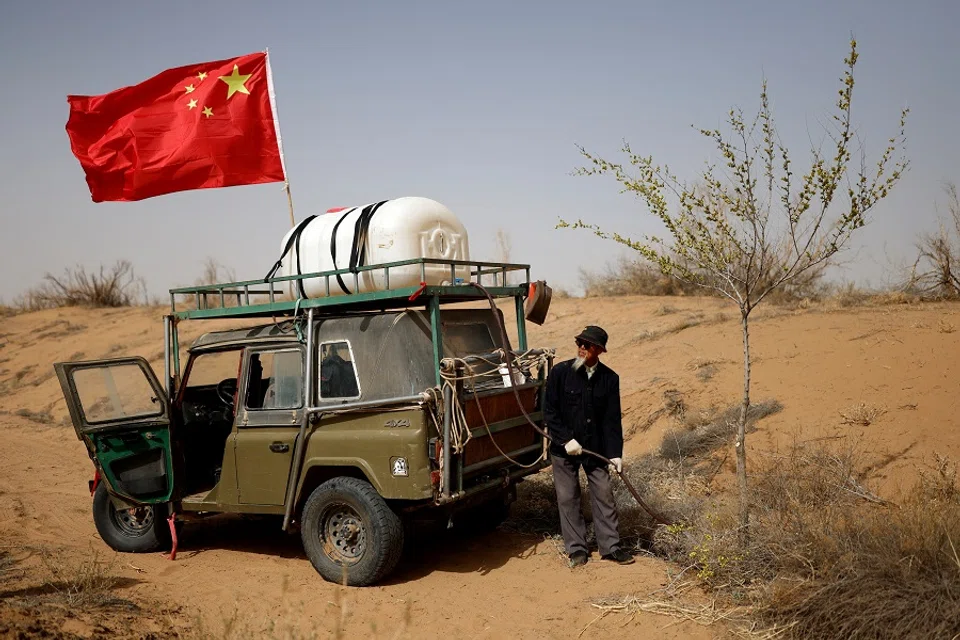Can China revive its poorer western provinces?
China has sought to rectify the imbalance in east-west regional development by improving connectivity and accelerating infrastructure-building in the western provinces through the Western Region Land-Sea Corridor and BRI projects. How successful they will be depends largely on continued capital injections, the region's greater opening up and good cooperation with China's neighbouring countries.

The Chinese government issued the Guiding Opinions of the CPC Central Committee and the State Council on Promoting the Formation of a New Pattern in the Large-scale Development of China's Western Regions in May 2020 and passed the Implementation Plan of Western Region Development Strategy of 14th Five-Year Plan in June 2021.
The Western Region Development Strategy (WRDS), or the Great Western Development Strategy, was officially launched in 2000 to rectify the imbalance in east-west regional development, especially through infrastructure improvement. The western region includes six provinces (Sichuan, Guizhou, Yunnan, Shaanxi, Gansu and Qinghai), five autonomous regions (Tibet, Ningxia, Xinjiang, Inner-Mongolia and Guangxi) and the municipality of Chongqing. Most of the western provinces had lagged far behind the other provinces of China in the late 20th century (Figure 1).

Mitigating the imbalance in regional development
Chinese paramount leader Deng Xiaoping set out the Two Grand Development Strategy in the 1980s to develop the country in stages, first with the eastern (coastal) region by accelerating reform and opening up. Development of the central-western region would come next after the coastal regions had acquired enough resources and technology to support the development of the inland region. The strategy was a clean break from Mao's egalitarian principle of "eating from the same big pot", which was a recipe for inactive development.
Then Chinese Communist Party (CCP) General Secretary Jiang Zemin launched the WRDS to promote four major infrastructure construction streams in hydraulics, transport, energy and telecommunications to facilitate the economic development of China's western region. This was after coastal cities such as Guangzhou, Shenzhen and Shanghai had prospered from the manufacturing boom that fuelled the economic growth of surrounding provinces in 1999. The first plan for WRDS was announced in 2002 and subsequently revised following every Five-Year Plan.
Occupying 70% of China's land area and nearly one-third of China's provincial-level administrative divisions, the western region could have performed better but it developed at a sluggish pace compared with the rest of the country. In the last 20 years, China's GDP made a quantum leap from 11 trillion RMB in 2001 to nearly 100 trillion RMB in 2019 but the percentage of GDP attributed to China's western region remained low (Figure 2). At the beginning of the 21st century, western provinces contributed 17.1% of GDP to the Chinese economy, registering an increase of about 3% after 10 years in 2011. Unfortunately, GDP growth has stagnated of late.
The WRDS, which was based on Deng Xiaoping's Two Grand Development Strategy, apparently did not receive much attention from investors outside of China even after 20 years.
With the BRI, the central government planned to establish international economic corridors along China, Mongolia and Russia; between Europe and Asia; between China, Central Asia and West Asia; between China and the Indochina Peninsula; between China and Pakistan; and between Bangladesh, China, India and Myanmar.

From inward-looking development to international connectivity
The Chinese government has been steadfast about its implementation of the WRDS. Beginning with the four major infrastructure areas, these were later expanded by Hu Jintao to include enhancing the density of the transport network. Xi Jinping further extended the strategy from the domestic domain to building international connectivity.
In the 11th Five-Year-Plan programme of work for the WRDS, transport projects, including highway, railway, airport and inland river navigation, were planned in some provinces to enhance the east-west connection. Based on the competitive advantage of the western region, sites for energy and chemical engineering, and the extraction and processing of mineral resources, especially in west-north provinces, were established.
The connection of the western region with neighbouring countries and the role of some sub-regions as logistic hubs were highlighted in the 12th Five-Year-Plan programme of work for the WRDS. Apart from expanding the airport network and the river navigating channels, the Chinese authorities aimed to build international railways, such as the China-Kyrgyzstan-Uzbekistan and Kunming-Singapore railways, and extend the highway network of the western region to Southeast Asia, South Asia, Central Asia and Northeast Asia to facilitate the international logistic corridor.
The 13th Five-Year-Plan programme of work for the WRDS aimed to coordinate western regions with the Beijing-Tianjin-Hebei economic belt, Yangtze River economic belt and the One Belt, One Road (later officially called Belt and Road initiative or the BRI). With the BRI, the central government planned to establish international economic corridors along China, Mongolia and Russia; between Europe and Asia; between China, Central Asia and West Asia; between China and the Indochina Peninsula; between China and Pakistan; and between Bangladesh, China, India and Myanmar.
Along with the BRI, the Chinese government announced the Western Region Land-Sea Corridor development in 2019. This offers a new dimension in the WRDS that would build a bridge between the Silk Road Economic Belt and the 21st Maritime Silk Road. The Corridor highlights the geographical advantage for international cooperation with Southeast Asia, South Asia, Central Asia, West Asia and Europe. This is established through the third Singapore-China government-to-government project - the China Singapore (Chongqing) Demonstration Initiative on Strategic Connectivity - and the New International Land-Sea Trade Corridor. The Central Asian Gas Pipeline Project, China-Central Asia-West Asia Economic Corridor, China-Europe Railway Express and so on are some of the projects parked under the New International Land-Sea Trade Corridor.
Even though the Chinese government has provided many preferential policies on infrastructure construction for western provinces via the WRDS, more capital is still needed to build, upgrade and coordinate the transport system and support modern logistics development.

As land transport between Western China and the surrounding areas draws the region closer, the Western Region Land-Sea Corridor will not only promote Western China as a link between various economic corridors and land-sea channels, but also ease the Chinese economy's over-reliance on maritime trade in the eastern region. It will also coordinate the domestic and international markets as well as the development of the Yangtze River Economic Belt by forming a sound transport and logistics system.
Challenges and prospects
The harsh geographical and poor economic conditions have made the lack of infrastructure, particularly effective transport facilities, a salient issue in western region development. Even though the Chinese government has provided many preferential policies on infrastructure construction for western provinces via the WRDS, more capital is still needed to build, upgrade and coordinate the transport system and support modern logistics development. For this reason, Chinese Premier Li Keqiang announced the release of another 100 billion RMB for the National Railway Construction Fund during the Two Sessions (两会 lianghui) of May 2020.
The BRI has become one of the important economic drivers for western development. It enhances the connectivity between China and countries along the BRI, and between China's western provinces as well. The guiding opinions of the WRDS has urged western provinces to join the BRI. Chinese government support for Xinjiang is given through the BRI's logistics and commercial activities. The government is concurrently promoting Sichuan, Chongqing and Shaanxi as regions for greater opening up; exploring the historical roles of Gansu and Shaanxi in the Silk Road Economic Belt; deepening ecological cooperation in Guizhou and Qinghai for green BRI development; preparing Inner Mongolia for the China-Mongolia-Russia Economic Corridor; and encouraging Yunnan to widen the Lancang-Mekong River regional cooperation.
The success of the BRI is highly contingent on the country's progressive engagement with foreign countries; the geopolitics and geoeconomics between Guangxi province and Vietnam, between Yunnan province and countries in the Indo-China peninsula, and between western provinces and Central and South Asian countries will affect the success of the BRI and western regional development.
Related: China's massive north-south gap in the cultural and economic realms | China's 14th Five-Year Plan will be a game changer | Why China's railway development has fallen short of Sun Yat-sen's expectations | Connecting Chongqing and Southeast Asia: Challenges and potential of China-Singapore (Chongqing) Connectivity Initiative



![[Photos] Fact versus fiction: The portrayal of WWII anti-Japanese martyrs in Taiwan](https://cassette.sphdigital.com.sg/image/thinkchina/3494f8bd481870f7c65b881fd21a3fd733f573f23232376e39c532a2c7593cbc)

